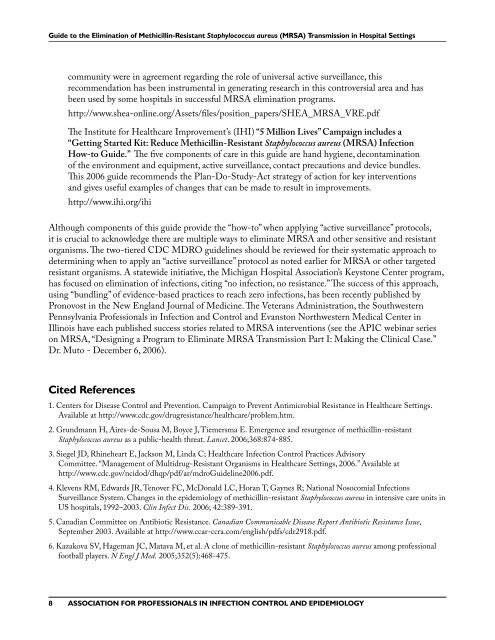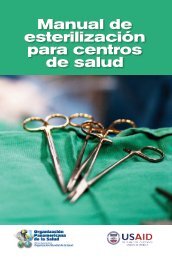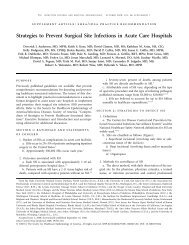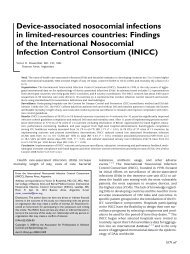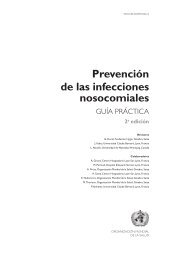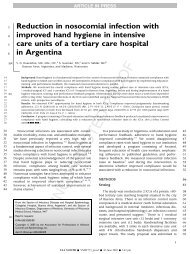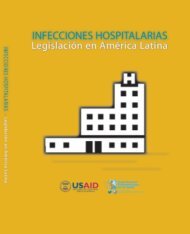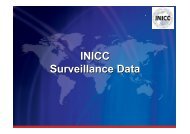APIC MRSA Elimination Guideline
APIC MRSA Elimination Guideline
APIC MRSA Elimination Guideline
Create successful ePaper yourself
Turn your PDF publications into a flip-book with our unique Google optimized e-Paper software.
Guide to the <strong>Elimination</strong> of Methicillin-Resistant Staphylococcus aureus (<strong>MRSA</strong>) Transmission in Hospital Settingscommunity were in agreement regarding the role of universal active surveillance, thisrecommendation has been instrumental in generating research in this controversial area and hasbeen used by some hospitals in successful <strong>MRSA</strong> elimination programs.http://www.shea-online.org/Assets/files/position_papers/SHEA_<strong>MRSA</strong>_VRE.pdfThe Institute for Healthcare Improvement’s (IHI) “5 Million Lives” Campaign includes a“Getting Started Kit: Reduce Methicillin-Resistant Staphylococcus aureus (<strong>MRSA</strong>) InfectionHow-to Guide.” The five components of care in this guide are hand hygiene, decontaminationof the environment and equipment, active surveillance, contact precautions and device bundles.This 2006 guide recommends the Plan-Do-Study-Act strategy of action for key interventionsand gives useful examples of changes that can be made to result in improvements.http://www.ihi.org/ihiAlthough components of this guide provide the “how-to” when applying “active surveillance” protocols,it is crucial to acknowledge there are multiple ways to eliminate <strong>MRSA</strong> and other sensitive and resistantorganisms. The two-tiered CDC MDRO guidelines should be reviewed for their systematic approach todetermining when to apply an “active surveillance” protocol as noted earlier for <strong>MRSA</strong> or other targetedresistant organisms. A statewide initiative, the Michigan Hospital Association’s Keystone Center program,has focused on elimination of infections, citing “no infection, no resistance.” The success of this approach,using “bundling” of evidence-based practices to reach zero infections, has been recently published byPronovost in the New England Journal of Medicine. The Veterans Administration, the SouthwesternPennsylvania Professionals in Infection and Control and Evanston Northwestern Medical Center inIllinois have each published success stories related to <strong>MRSA</strong> interventions (see the <strong>APIC</strong> webinar serieson <strong>MRSA</strong>, “Designing a Program to Eliminate <strong>MRSA</strong> Transmission Part I: Making the Clinical Case.”Dr. Muto - December 6, 2006).Cited References1. Centers for Disease Control and Prevention. Campaign to Prevent Antimicrobial Resistance in Healthcare Settings.Available at http://www.cdc.gov/drugresistance/healthcare/problem.htm.2. Grundmann H, Aires-de-Sousa M, Boyce J, Tiemersma E. Emergence and resurgence of methicillin-resistantStaphylococcus aureus as a public-health threat. Lancet. 2006;368:874-885.3. Siegel JD, Rhineheart E, Jackson M, Linda C; Healthcare Infection Control Practices AdvisoryCommittee. “Management of Multidrug-Resistant Organisms in Healthcare Settings, 2006.” Available athttp://www.cdc.gov/ncidod/dhqp/pdf/ar/mdro<strong>Guideline</strong>2006.pdf.4. Klevens RM, Edwards JR, Tenover FC, McDonald LC, Horan T, Gaynes R; National Nosocomial InfectionsSurveillance System. Changes in the epidemiology of methicillin-resistant Staphylococcus aureus in intensive care units inUS hospitals, 1992–2003. Clin Infect Dis. 2006; 42:389-391.5. Canadian Committee on Antibiotic Resistance. Canadian Communicable Disease Report Antibiotic Resistance Issue,September 2003. Available at http://www.ccar-ccra.com/english/pdfs/cdr2918.pdf.6. Kazakova SV, Hageman JC, Matava M, et al. A clone of methicillin-resistant Staphylococcus aureus among professionalfootball players. N Engl J Med. 2005;352(5):468-475.ASSOCIATION FOR PROFESSIONALS IN INFECTION CONTROL AND EPIDEMIOLOGY


